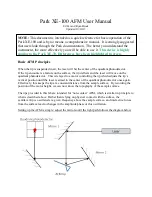
14
You can adjust the focus of the prepared slide im
-
age using the focus knob (2). Make sure to swivel
the microscope arm (9) back into an upright po
-
sition so that you can comfortably observe the
specimen.
In a dark room, it is also possible to project the
microscope picture on a white wall. To do this, re
-
move the matt screen. Swivel the tripod so that the
upper edge of the projector is horizontal. Keep in
mind that the image brightness is reduced and the
picture will be darker if the projector is far away
from the wall.
Experiments
Now that you’re familiar with your microscope’s
functions and how to prepare slides, you can com
-
plete the following experiments and observe the
results under your microscope.
Newspaper print
Objects:
1. A small piece of paper from a newspaper with
parts of a picture and some letters
2. A similar piece of paper from an illustrated
magazine: Use your microscope at the lowest
magnification and make a slide preparation
from each object. Place the slide with the
newspaper on the microscope table and
observe the slide. The letters in the newspa
-
per appear broken because the newspaper is
printed on raw, inferior paper. Now observe the
slide with the magazine preparation. Letters
of the magazine appear smoother and more
complete. The picture from the newspaper
consists of many small points, which appear
somewhat dirty. The pixels (raster points) of
the magazine image appear sharper.
Textile fibres
Objects and accessories:
1. Threads of different textiles: Cotton, linen,
wool, silk, Celanese, nylon and any others you
can find.
2. Two needles: Put each thread on a glass slide
and fray each with the help of the two needles.
Put a drop of water over each thread with the
pipette and cover each with a cover glass.
Adjust the microscope to a low magnification.
Cotton fibres are of plant origin and look, under
the microscope, like a flat, twisted band. The
fibres are thicker and rounder at the edges than
in the centre. Cotton fibres consist primarily of
long, collapsed tubes. Linen fibres are also of
plant origin; they are round and run in straight
lines. The fibres shine like silk and exhibit
numerous swellings along the shaft of the
fibre. Silk is of animal origin and consists of
solid fibres of smaller diameter than the hollow
vegetable fibres. Each silk fibre is smooth and
even and has the appearance of a small glass
rod. Wool fibres are also of animal origin; the
surface consists of overlapping scales, which
appear broken and wavy. If possible, compare
wool fibres from different weaving mills, and
note the differences in the appearance of the
fibres. Experts can determine the country of
origin of wool based on its appearance under a
microscope. Celanese is artificially manufac-
tured by a long chemical process. All Celanese
fibres show hard, dark lines on a smooth,
shining surface. The fibres crinkle in the same
way after drying. Observe the similarities and
differences between the different fibres.









































